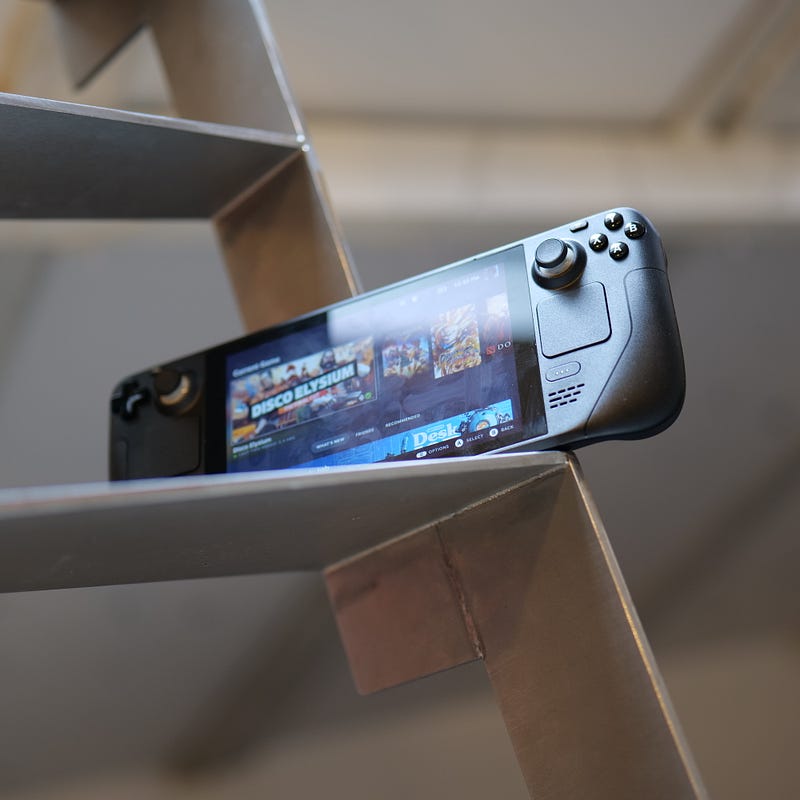My Full Steam Deck Review
My full Steam Deck review after two months of use by my wife and I

Full Steam Deck Review And Bugs
Expectations
Let us get something straight, this is not going to be a review of how the Steam Deck performs when playing graphically intensive Triple-A games like you see from some reviews. Unlike many of the reviewers out there, I know what this thing is — and what it is not. Do not get this thinking you are going to play Horizon Zero Dawn at 60FPS, more like 40FPS. Or Destiny 2, because that anti-cheat system does not work on Steam Deck; even though it works on Linux since it runs on Google Stadia, and we know that runs Linux.
So many reviewers are comparing the Steam Deck to the latest consoles and that is not what it is, a next-gen console. You are not getting Xbox Series X or PS5 performance out of this handheld. Some reviewers compare it to the Nintendo Switch, for good reason. However, you are not playing those Nintendo exclusives (without an emulator).
The Steam Deck sits somewhere in-between a Nintendo Switch and the Xbox Series S. It is more powerful than the Nintendo Switch, but not as powerful as the Xbox Series S, something in-between. The games you are going to play range from indie games to some Triple-A, but I will cover that later. Think more Final Fantasy 7 (remake) and Battlefield 4.
Build Quality and Size
The build of the Steam Deck is solid, consisting of durable plastic. The button layout, at least for my wife and I, is comfortable. We can easily game for an hour with no issue. Some people have complained about the weight, but neither of us see it. If the size and weight are of concern, there are stands that you can get, and since it is running Linux, the drivers for all your controllers are built-in. If I know I want to play for an extended period, and do not want to hold it I can then dock it with my TV or computer monitor and plug up a controller (or use the PlayStation Bluetooth controller).
Game Performance
In the time that I have had the Steam Deck, I have been able to play several games in my Steam library, and the performance has been great. I can easily hit 60FPS in games like Borderlands 3, Battlefield 4, Minecraft Dungeons, and Apex Legends. Now, that is not going to be at the highest graphical settings, but games typically default to a good pre-set that works with the Steam Deck. I am not going to go into too much depth here, there are a lot of benchmark and review videos you can watch on YouTube. However, the games I have been playing and enjoy the most are:
- Final Fantasy 7 (remake)
- Minecraft Dungeons
- Battlefield 4
- Apex Legends
- Borderlands 3
- Mini Motorways
It is not all sunshine and unicorns, you will occasionally see dips in the framerate, but absolutely nothing that made me disappointed. This is all subjective; so again, you should checkout benchmarks for the game(s) you want to play.
40FPS
Valve added a 40FPS mode to the Steam Deck. This will allow you to limit how fast a game is refreshed on the screen and saving you battery life — a nice middle ground between performance and battery life. Some people see the 40FPS mode and think, why would I want to play at a frame rate that low…. While I understand the knee-jerk reaction to that, it is not actually that bad. Many games play great at that frame rate. You would not want to play competitive games like Apex Legends at that rate, but games like Minecraft or Final Fantasy 7 play great.
Battery
The battery life is okay. Look, this is PC gaming, and you are getting wild times because games are wildly different. Some games will require extraordinarily little resources, and some require a lot. The battery life I get out of the Steam Deck is going to be quite different when playing Borderlands 3 vs Minecraft Dungeons. I have never run out of battery life; this is how I do it.
First, if I am gaming for an extended period, I am plugged up anyway (unless in a moving vehicle). If I am home and playing a game with my wife, I am usually docked or plugged up to the wall. If I am out of the house, I utilize the frame rate limiter and limit the TDP (limiting the power usage). This allows me to tweak the resource usage of games to squeeze out as much time as possible. This does require you to modify settings in the Quick Settings, but you can quickly figure it out or watch a short video on how to do it. I turn settings down until I find it unacceptable, and then adjust things up until it is playable. Again, because games are so wildly different, you need to do this per-game.
You do not have to play around with these settings, but there are tools on the Steam Deck to allow you to get more battery life out of it. You can also get a battery pack.
Shader Cache
I believe this is a problem Valve needs to solve. Right now, if you were to get the 64GB Steam Deck, you are more likely to experience this issue. Especially if you intend to install a lot of games on your SD card(s). The problem is around the shader cache. As you install games, Steam is going to pre-cache the shaders so that when you play, it already has the shaders compiled for the Steam Deck — which makes games play smooth. However, once it does this, it stores the cache on the internal drive. I have had to go into the “shadercache” folder (/home/deck/.local/share/Steam/steamapps/shadercache/) multiple times to delete folders as I would not be able to do anything on the Steam Deck until I freed up space. When you look at your internal drive in the SteamOS interface, all you can see is “Other” using up 90% of your storage. Right now, “Other” is using 33GB on my 64GB Steam Deck, and all my games are installed on the SD card.
Again, yes, I can band aid this for now, but imagine the gamers that will tell their friends how bad the Steam Deck is because they ran out of space and there’s NO way to clear it without going into Desktop Mode and knowing what folder to clean up… not a good user experience.
External Storage
If you are using an SD card in the slot at the bottom of your Steam Deck, then this is straight forward. You format the SD card, and it handles the rest — much like any other consoles. If you want to use an external hard drive, or use an SD card plugged into your dock, no go. This is something that the PlayStation and Xbox have; however, it is not something you will easily be able to do in the Steam Deck interface.
Not saying you cannot, once you switch to Desktop Mode you have access to the Linux system. You can easily setup an external 5TB hard drive, setup the mounts in fstab (or Autofs), and add it to Steam. Voilà, you have 5TB of storage for your Steam Deck. The problem is most gamers do not know how to do that, or what the previous sentence even means. If someone is buying a handheld console like this; they do not want to do that. The wonderful thing is that this is software, and the functionality can be added into the Steam Deck interface because the tools already exist on the Steam Deck.
Some Bugs
External resolution in Game Mode is lacking. Other consoles have had this ability for years and is something they need to add to the Steam Deck. When I plug my Steam Deck up to my gaming monitor and try to launch a game, it switches to a resolution that my monitor cannot support. So, I must switch to Desktop Mode to play because it plays the games at native resolution to my monitor.
When bringing up the Steam Overlay, you will occasionally run into flickering where it flickers between the Steam Overlay and the running game. I could see this being fixed since they maintain their own desktop manager, so they can control what screen should be on top.
Bricked SD cards is a problem Valve is aware of and is working on fixing. I experienced this problem as I have multiple 256GB and 512GB SD cards — I download a lot of games. I had this issue happen to me once in the two months I have had the Steam Deck. This could happen when hot swapping SD cards.
Desktop Mode
This mode allows you to dock your Steam Deck and use it like a desktop. Why would you do this? Well, SteamOS is a very stable Linux distribution. So, you have a full desktop environment, and with that you have desktop applications. In fact, I am typing this article on the Steam Deck. You also have access to the Discover app store, which allows easy installation of Linux applications. Or you can just use your web browser since most companies have a web version of their software.
Games
Right now, there are over 4,000 games marked as playable on the Steam Deck. When you buy this thing, you are going to have access to an enormous collection of games to play. When I picked mine up, out of the 200+ games (and dozens of games through EA play) I have 42 that are fully playable on the Steam Deck. I have 109 that are verified or playable, meaning some games may require you to click through some interfaces or requires a login with the on-screen keyboard. Lastly, 211 games that are verified, playable, or untested. I have had surprisingly good luck with the untested games, but you could run into issues if the game developer has chosen to not allow their anti-cheat to work on Linux (most of the top anti-cheat solutions already support Linux).
Recommend
Would I recommend the Steam Deck to others? If you are looking to bring your PC games on the go. Or if you are trying to game on the go with something more powerful than your phone or Nintendo Switch, then yes. I would recommend the Steam Deck. My wife and I love gaming on this thing, and we must learn to share it. I can finally play powerful games on the go or sit with my two-year-old as she watches her movie and I play my games.
